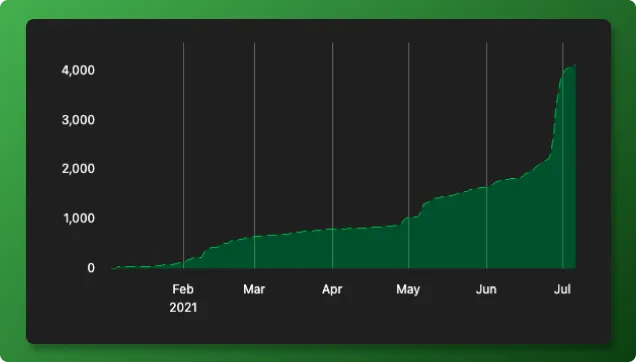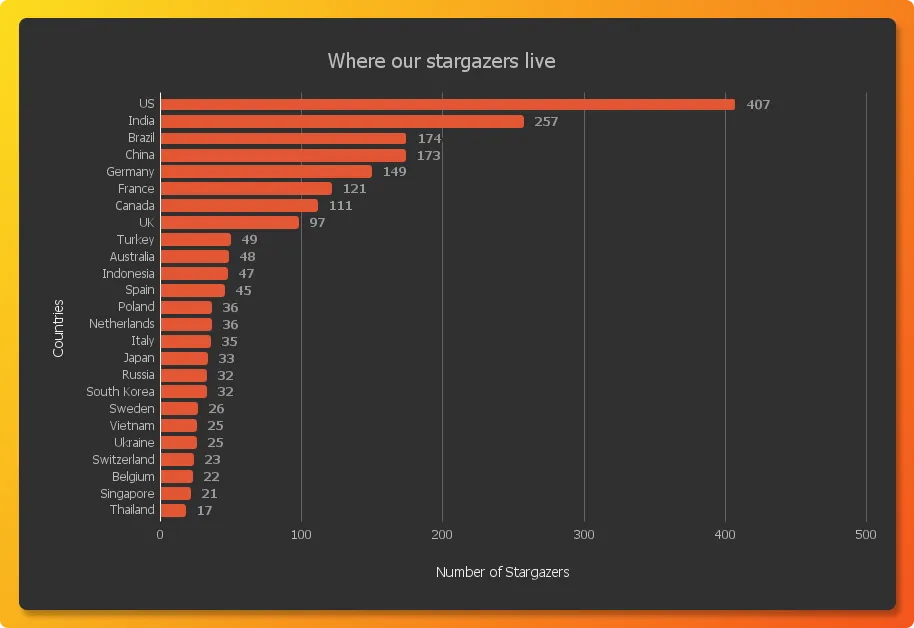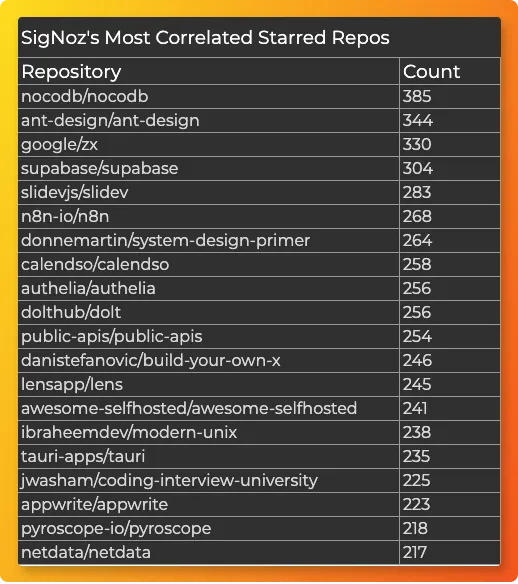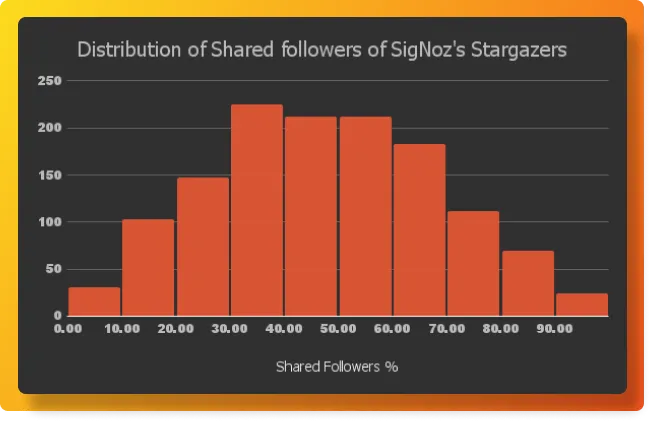title: Getting to know our 4000+ stargazers on GitHub slug: getting-to-know-our-4000-plus-stargazers-on-github date: 2021-07-10 tags: [SigNoz, Community] authors: [ankit_anand] description: SigNoz crossed 4000+ stars recently. In this article, we dig deep to find out about our GitHub stargazers using a tool called Stargazers. image: /img/blog/2021/08/stargazers_cover_hc.webp keywords: [github stargazers,stargazers analysis,SigNoz] ---In a little over 4 months, we have crossed 4k+ stars on our GitHub repo. In this article, we explore what we can learn from our GitHub stars.

As the maintainers of an active open source project, we have often wondered what do our stars mean? According to GitHub docs, starring is a way for people to keep track of projects they find interesting. GitHub uses this data to recommend relevant content to its users.
> Starring a repository also shows appreciation to the repository maintainer for their work. - GitHub docs
There are more than 100 million repos live on GitHub. So for GitHub as a platform where developers collaborate, it makes sense to use starring to source repos that are generating interest in the community. The explore section of GitHub shows popular repositories based on the number of stars they have.
That means GitHub stars can increase the discoverability of a repo. We have noticed this ourselves whenever our repo got featured in the trending section of GitHub.
Recently, we crossed 4k+ stars on GitHub, and we thought it is a good moment to learn more about our stargazers. Spencer Kimball, the CEO of Cockroach Labs, has built an amazing tool called Stargazers, to analyze a repo's stargazers. He wrote an excellent article on CockroachDB's stargazers. We used Spencer's tool to analyze our stargazers and found out some interesting things!
What drives GitHub stars?
The success of an open-source project is largely dependent on its community. As such, we make it a point to be active in any community related to our project. And the first rule of community is to be helpful. Therefore, our team members go out on public forums answering questions on topics related to application monitoring.
Posting about our project on subreddits related to our space helps in driving traffic to our GitHub repo. Creating helpful content is our only go-to-market strategy when it comes to creating awareness about SigNoz. Our blog series on setting up SigNoz to monitor applications written in Nodejs, Go, and Python did well in getting users interested.
The massive bump in our GitHub stargazers came from trending across all programming languages on GitHub. You can consider the trending page as a front-page for developers active on GitHub worldwide, and to be featured there certainly helped us a lot.

Where are our stargazers from?
We are building a full-stack monitoring & observability tool to help developers keep their applications in fine health. The shift of application architecture from monolithic to microservices architecture makes it more difficult for developers to track their application's performance.
Given the universal nature of the problem we are solving, our tool should be helpful for devs across the globe. But even then, we were pleasantly surprised to find that our stargazers belonged to 110 different countries!
Here's a distribution of our stargazers from the top 25 countries.

This puts an extra responsibility on us to build a truly global product. We are also working on making our community more diverse. So wherever you are reading this from, come and get involved with our GitHub repo. 😊
What else does our stargazers like?
One of the coolest things about Spencer's code was that we could see what other GitHub repositories seemed interesting to our stargazers. Of course, we understand that starring a repo is relatively easy, and GitHub users can star many repos. Still, this data gives us a general sense of what's interesting to our stargazers.

In the list, we can find some interesting developer tools. NocoDB is an open-source alternative to a popular SaaS product called Airtable. We have other developer tools on the list like Supabase, Authelia, and Dolt. This makes sense as SigNoz is also a developer tool. We are an open-source alternative to APM tools like DataDog, New relic, etc. Our stargazers also seem to be interested in open-source alternatives of popular closed SaaS products.
How active are our stargazers?
20.53% of our stargazers have made at least one commit. The total commits made by SigNoz's stargazers stood at 317k, with the top 15 making 122k commits out of the total. Spencer's code took care that only repositories that had more than 25 stargazers, 10 forks, or 10 issues were included to make this calculation.
This shows that the developers who are starring our repo are active developers actively exploring new tools.
Here are the commit stats of our top 20 stargazers.

Are our stargazers connected among each other?
On other social platforms like Facebook and Instagram, it's normal to expect a high degree of interconnectedness in networks of friends and family. But can we expect such behavior to play out on a developer platform like GitHub? In short, we wanted to know does our stargazers follow each other!
2239 stargazers of SigNoz had a total followers count of 119k GitHub users, out of which they shared 47k followers. Developers want to connect! And what better platform than GitHub. Removing users with less than 10 followers, we plotted a histogram for the percentage of shared followers of our stargazers. 45.5% of our stargazers have an overlap of atleast 50% in their followers with other stargazers of SigNoz.
And as we have been starred from 110 different countries, we can be certain that this is a platform-wide phenomenon not specific to a particular location.

What's next?
It feels good to have 4k+ stars on our GitHub repo, and we are definitely hoping to grow more on that front. At the same time, we are working on being more helpful to our community. Creating more helpful content, keeping our docs and FAQs updated, giving more demos, etc.
An open-source project is only truly successful when it is built with active community participation, and we're lucky to be headed that way.
If you want to drop by and say hi, here's a link to our slack community.
You can try out the Stargazers tool for your repo or any repo you would like to analyze.
If you're looking for a full-stack monitoring & observability tool, feel free to check out our GitHub repo 👇

